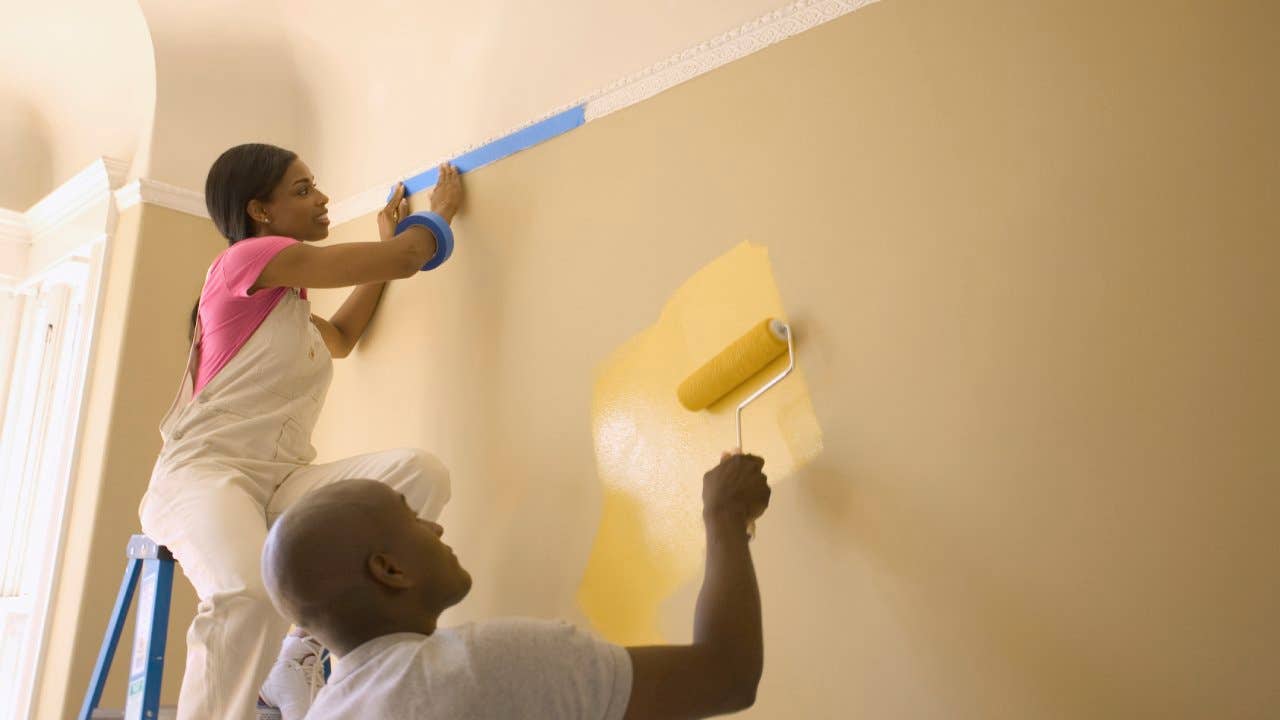5 tips for house-painting like a pro

Those white walls are so dull — you need a splash of color in your life — or you’re noting the appearance of some cracks and chips. Whatever, the inside of the house definitely needs a paint job.
It’s pricey, though: The average cost to paint an interior ranges from $1,200 to $3,900. Given the bulk of that is the painter’s fee, it’s easy to see why many people are tempted to go the DIY route. When you eliminate the labor costs of house painting, it becomes much more affordable.
A gallon of paint will cost $25 to $55, depending on the brand and quality; glossier paint tends to be more expensive than matte options. Each gallon of paint will cover about 350-400 square feet and will likely require two coats. For a 1,200 square foot home, that means you should budget about $400 for paint to cover two coats on all surfaces. Budget for a few rollers, painters tape, and tarps — and you can usually complete the entire job for about $500.
But how can you complete the job like a pro? Aside from obvious tips like covering your furniture and not painting yourself into the proverbial corner, there are some secrets to improving your results. Here are five tips, tricks and techniques to ensure you’ll do a professional-looking paint job.
1. Wait for the right weather
If it’s rainy or the forecast predicts rain, it’s not a good day to paint. The ideal humidity for painting is between 40-50 percent. When the humidity is too high, you are likely to wind up with streaks in your paint or unwanted spots. If it’s cold and humid, your paint may develop condensation on the surface.
If it’s dry but a scorcher of a day, that’s not good either. The paint could dry too fast, developing cracks, bumps or blisters. Latex and acrylic paints won’t do well if the ambient temperature in the house is above 85 degrees, while oil paints will suffer if you paint when the temperature exceeds 90 degrees. If it’s hot outside, make sure you run the air conditioner in the room awhile before you paint — even if you have the windows open for ventilation.
2. Choose the right roller nap
The length of fibers on your paint roller are called nap. Different surfaces require different naps. If your walls are very smooth (no texture), a very short nap is appropriate; you’ll want to stick with ¼-inch for ideal results. Most interior walls have some light texturing and will benefit from ⅜-inch nap. For more textured surfaces like brick, consider a ½- or ¾-inch nap.
Avoid 1-inch nap for interior painting, since these rollers are usually reserved for things like exterior stucco.
3. Blend your paint before you begin
Did you know that even if you buy three gallons of the same paint at the same time, they may not be identical? A paint machine can yield slight variations when mixing the same hue. To ensure uniform coverage across your room, you may want to blend the cans before you get started.
Get a five-gallon paint bucket and combine all of your individual gallon cans. Stir with a paint stick to create a single color that will remain consistent across the space. If you have extra paint, you can always pour the excess back into a 1-gallon can.
4. Consider self-priming paint
Contractors often like to use primer before they apply paint. Primer serves two main purposes: it seals the surface of the wall and provides better adhesion for the paint color (similar to the way foundation smooths and “preps” your face for makeup).
However, most DIY painters don’t need to invest in a primer if they purchase a self-priming paint. Self-priming paint seals the wall as it applies color. Eliminating primer can save you money and time. A separate primer is especially discretionary if you’re painting over existing paint and not drywall.
5. Work with a wet edge
Once you get to rolling, you want to be careful with your technique to provide consistent coverage — and the key to that is keeping a wet edge. This means every stroke of your roller should overlap with the previous one. Start in one corner, working from top to bottom, and move your roller so you are moving over in slow increments. You also want to refill your roller often, rolling it in paint again before it becomes completely dry. Backtrack as needed to reapply paint over a noticeably thin area, a bubble, or a streak.
One final tip: Just let your roller do the work and don’t press it too hard against the wall.
Final word on painting like a pro
Whether you want to paint your entire house or you’re just adding an accent wall, you can save a lot of money by learning how to paint your home yourself. If you choose high-quality paint, prepare your space properly (liberally use fabric drop cloths and blue painters tape to protect edges) and avoid putting too much pressure (literally) into the work, there is no reason you can’t end up with a stellar result.





